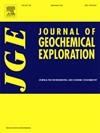印度Dharwar克拉通Chitradurga绿岩带Paramanahalli独居石化学及成矿时间:金矿找矿意义
IF 3.4
2区 地球科学
Q1 GEOCHEMISTRY & GEOPHYSICS
引用次数: 0
摘要
paranahalli金矿床位于西Dharwar克拉通Chitradurga绿岩带,是一个剪切带型金矿床,成矿作用局限于碳酸化变质玄武岩和带状铁组。成矿带矿物组合为绿泥石(富铁)+石英+铁白云石+金红石+独居石±黄铁矿±金。碳酸化变质玄武岩(强烈蚀变岩)中的独居石;根据其产状、结构和化学成分,特别是其较低的ThO2含量,近蚀变带被解释为热液成因,而片状变质玄武岩(蚀变最小的岩石;远端蚀变带),发现是变质的。矿化带热液独居石富集轻稀土元素lree (La2O3 + Ce2O3 >;51 wt%),并表现出低的ThO2浓度(<1.5 wt%),被归类为异常值,与变质独居石相比,含有较低的lree (La2O3 + Ce2O3 <;45 wt%)和更高的ThO2 (>;1.5 wt%)作为背景值。Ce/Pr、La/Nd、La/Pr等比值及稀土元素变化趋势可作为造山带金矿找矿的诊断工具。该研究强调了独居石作为地球化学工具的作用,可以揭示成矿带,从而加强对达尔瓦尔克拉通及类似地体造山带型金矿的找矿策略。值得注意的是,我们首次报道了Paramanahalli与金矿化有关的热液事件的时间,通过电子探针显微分析估计了独居石的化学年龄(CHIME)。研究表明,该矿床年龄为2622±08 Ma(较老)和2510±12 Ma(较年轻),分别对应于变质作用和同矿热液蚀变/成矿作用。Paramanahalli的新太古代成矿事件(2510±12 Ma)与西Dharwar克拉通Ajjanahalli(2520±9 Ma)和Gadag(2522±6 Ma)的金矿成矿年龄非常接近。研究结果表明,在2520 Ma左右的区域构造-热事件中,整个西断带的金矿成矿作用以大量流体进入地壳为特征。本文章由计算机程序翻译,如有差异,请以英文原文为准。
Monazite chemistry and timing of mineralization at Paramanahalli, Chitradurga Greenstone Belt, Dharwar Craton, India: Implications for gold exploration
Paramanahalli gold deposit, Chitradurga greenstone belt in the Western Dharwar Craton, is a shear zone-hosted/ structurally controlled, mineralization confined to carbonated metabasalt and Banded Iron Formation. Chlorite (Fe-rich) + quartz + ankerite + rutile + monazite ± pyrite ± gold is the mineral association found in the mineralized zone. Monazite from carbonated metabasalt (intensely altered rocks; proximal alteration zone) is interpreted as hydrothermal in origin, based on its mode of occurrence, texture, and chemical composition, particularly its low ThO2 content, whereas monazite grains from schistose metabasalt (least altered rocks; distal alteration zone), found to be metamorphic. Hydrothermal monazite from the mineralized zone is enriched in light rare earth elements LREEs (La2O3 + Ce2O3 > 51 wt%) and exhibits low ThO2 concentrations (<1.5 wt%) classified as anomalous values, in contrast to metamorphic monazite, contain lower LREEs (La2O3 + Ce2O3 < 45 wt%) and higher ThO2 (> 1.5 wt%) identified as background values. The ratios such as Ce/Pr, La/Nd, La/Pr, along with REE trends, serve as diagnostic tools to target and exploration of orogenic gold deposits. This study highlights the utility of monazite as a geochemical tool to unravel mineralized zones, thereby enhancing exploration strategies for orogenic-type gold mineralization in the Dharwar Craton and similar terranes. Notably, we are the first to report the timing of a hydrothermal event related to gold mineralization at Paramanahalli by estimating the chemical ages (CHIME) of monazites through Electron Probe Micro Analysis. The study reveals two distinct ages: 2622 ± 08 Ma (older) and 2510 ± 12 Ma (younger), corresponding to metamorphism and syn-ore hydrothermal alteration/mineralization events, respectively. The Neoarchean mineralization event at Paramanahalli (2510 ± 12 Ma) aligns closely with ages estimated for gold mineralization in Ajjanahalli (2520 ± 9 Ma) and Gadag (2522 ± 6 Ma) within the Western Dharwar Craton. Our findings indicate that gold mineralization across the WDC is attributed to a regional tectono-thermal event around 2520 Ma, characterized by extensive fluid flux into the crust.
求助全文
通过发布文献求助,成功后即可免费获取论文全文。
去求助
来源期刊

Journal of Geochemical Exploration
地学-地球化学与地球物理
CiteScore
7.40
自引率
7.70%
发文量
148
审稿时长
8.1 months
期刊介绍:
Journal of Geochemical Exploration is mostly dedicated to publication of original studies in exploration and environmental geochemistry and related topics.
Contributions considered of prevalent interest for the journal include researches based on the application of innovative methods to:
define the genesis and the evolution of mineral deposits including transfer of elements in large-scale mineralized areas.
analyze complex systems at the boundaries between bio-geochemistry, metal transport and mineral accumulation.
evaluate effects of historical mining activities on the surface environment.
trace pollutant sources and define their fate and transport models in the near-surface and surface environments involving solid, fluid and aerial matrices.
assess and quantify natural and technogenic radioactivity in the environment.
determine geochemical anomalies and set baseline reference values using compositional data analysis, multivariate statistics and geo-spatial analysis.
assess the impacts of anthropogenic contamination on ecosystems and human health at local and regional scale to prioritize and classify risks through deterministic and stochastic approaches.
Papers dedicated to the presentation of newly developed methods in analytical geochemistry to be applied in the field or in laboratory are also within the topics of interest for the journal.
 求助内容:
求助内容: 应助结果提醒方式:
应助结果提醒方式:


